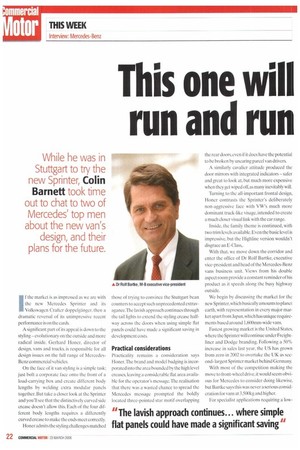This one will run and run
Page 22

Page 23

If you've noticed an error in this article please click here to report it so we can fix it.
If the market is as impressed as we are with the new Mercedes Sprinter and its Volkswagen Crafter doppelgiinger, then a dramatic reversal of its unimpressive recent performance is on the cards.
A significant part of its appeal is down to the styling — evolutionary on the outside and more radical inside. Gerhard Honer, director of design, vans and trucks, is responsible for all design issues on the full range of MercedesBenz commercial vehicles.
On the face of it van styling is a simple task; just bolt a corporate face onto the front of a load-carrying box and create different body lengths by welding extra modular panels together. But take a closer look at the Sprinter and you'll see that the distinctively curved side crease doesn't allow this. Each of the four different body lengths requires a differently curved crease to make the ends meet correctly.
Honer admits the styling challenges matched those of trying to convince the Stuttgart bean counters to accept such unprecedented extravagance.The lavish approach continues through the tail lights to extend the styling crease halfway across the doors when using simple flat panels could have made a significant saving in development costs.
Practical considerations Practicality remains a consideration says Honer. The brand and model badging is incorporated into the area bounded by the high level creases, leaving a considerable flat area available for the operator's message. The realisation that there was a wasted chance to spread the Mercedes message prompted the boldly located three-pointed star motif overlapping the rear doors, even if it does have the potential to be broken by uncaring parcel van drivers.
A similarly cavalier attitude produced the door minors with integrated indicators — safer and great to look at, but much more expensive when they get wiped off, as many inevitably will.
Turning to the all-important frontal design. Honer contrasts the Sprinter's deliberately non-aggressive face with VW's much more dominant truck-like visage, intended to create a much closer visual link with the car range.
Inside, the family theme is continued, with two trim levels available. Even the basic level is impressive, but the Highline version wouldn't disgrace an E-Class,.
With that. we move down the corridor and enter the office of Dr Rolf Bartke, executive vice-president and head of the Mercedes-Benz vans business unit. Views from his double aspect room provide a constant reminder of his product as it speeds along the busy highway outside.
We begin by discussing the market for the new Sprinter,which basically amounts to planet earth, with representation in every major market apart from Japan,which has unique requirements based around 1,600mm-wide vans.
Fastest growing market is the United States, where the Sprinter will continue under Freightliner and Dodge branding. Following a 50% increase in sales last year, the US has grown from zero in 2002 to overtake the UK as secondlargest Sprinter market behind Germany.
With most of the competition making the move to front-wheel drive, it would seem obvious for Mercedes to consider doing likewise, but Bartke says this was never a serious consideration for vans at 3,500kg and higher.
For specialist applications requiring a low frame height, primarily motorhomes, the new Sprinter will have an ALKO semi-trailing independent rear suspension conversion, which gives a 205mm reduction at a 3,880kg GVW Huge numbers It may seem perverse to drop the Sprintshift automated transmission while others, including Volkswagen with the Crafter, are adopting such units. Bartke explains that torque-converter fully automatic transmissions are built for M-R passenger ears in such huge numbers that the cost is similar to the much simpler Sprinishift,but the shift quality is much better.
I remind him of a previous visit to the same building to hear about Mercedes' brave new entry to the sub-Vito sector. The Vaneo was launched as a passenger version, but the intended commercial version failed to appear. Bartke acknowledges that it proved impossible to build a an to Mercedes' standard at a competitive cost.There are no more plans for a small Mercedes van, either built in-house or through any Sprinter-style platform-sharing basis.
From the van that never was, our discussion turns to the van that refuses to die. Asked how long the Vario will survive, the blunt answer is "as long as it makes money".The forthcoming facelift and interior revamp do little to alter the fact that the big van's tooling costs were written off years ago. The current 4,000 units per year provide a more than big enough contribution to DaimlerChrysler's coffers to ensure its likely survival until at least the arrival of Euro-5. This brings us neatly to the subject of future fuels for Mercedes vans. While the Vario will take the SCR route to Euro-4, the Sprinter and Vito are confirmed EGR players, although SCR (BlueTec in Mercedes-speak) could feature at Euro-5.
Mercedes' most public future fuel policy is the hydrogen fuel cell. Prototypes are already running, but the target for a practical and affordable system is the end of the decade, with significant numbers not arriving until 2015. Other technologies under consideration are hybrids, both petrol and diesel-fuelled, and LNG. Rio-diesel currently needs advances in injector technology to progress much beyond the current 5% blend.
Having driven the new Sprinter and spoken to the men behind it, it's arguably the biggest single leap in large vans since the launch of the original Ford Transit. It demonstrates a visibly increased confidence that befits the company's position as the largest CV manufacturer in the world, exemplified by technical and design solutions that would probably be dismissed as uneconomic by most rivals.
All it has to do now is convince the buyers.




































































































































































































